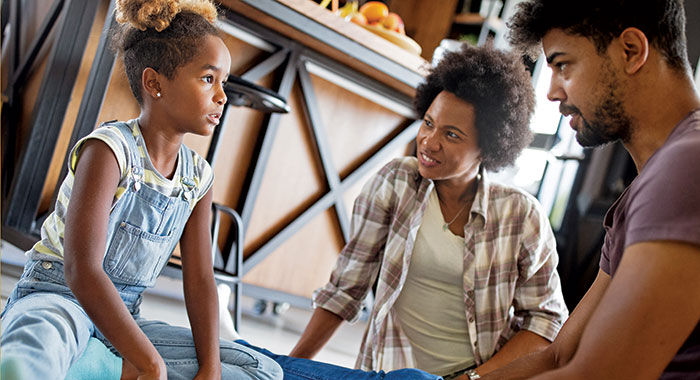My official childhood education on puberty came from the mandatory fifth grade school presentation when they separated the boys from the girls. What I thought of as the “real” education came from my friends sharing (often wildly-inaccurate) information picked up from older siblings and other friends. What I ended up with as I experienced this rite of passage was a mishmash of semi-facts that I was left to muddle my way through. It was an extremely common experience for my generation.
Determined to arm my kids with the truth and to somehow make talking about puberty less cringe-inducing (on all our parts), I dug into researching the best way to go about it. I knew I wanted my kids to have accurate information, rather than the hearsay of friends, and I also wanted to communicate our family values around this business of becoming an adult.
Start young
The best place to begin is by using the proper names for body parts. Somehow it is easier to use the correct words with a young child than to finally begin to use them with a 12-year-old. Children will have no embarrassment associated with those words if they have simply grown up using them. It is also important that children be able to discuss their physical health with a doctor or other trusted adult and be properly understood, which is trickier if we use cutesy nicknames for body parts.
We might not realize it, but kids are exposed to the birds and the bees from a very young age. I vividly remember a zoo visit where my three-year-old son spotted turtles “wrestling.” When my oldest daughter was three, I would have left it at “wrestling” and called it a bullet dodged. However, at that point, I realized I could use the moment to correct his interpretation.
Keep it simple
Consider what you share and tailor it to your child’s age. In the turtle example, the conversation looked like: “Actually, those turtles are making a baby. It takes a part from a boy turtle, called sperm, and a part from a girl turtle, called an egg, to make a baby.” I said it matter-of-factly and kept it short and simple. My son took it in, nodded, and turned back to watch the turtles, leaving me to quietly sigh in relief at how this new approach could work.
As your child ages, gradually expand the level of detail and information you provide, so that by the time he reaches that fifth grade presentation, he has already heard it all; and, better yet, so that by the time he hears playground misinformation – and that comes younger than you would think – he has the knowledge to accurately filter what he hears.
What if your child is in middle or high school and you still haven’t had a single conversation about puberty and growing up? It’s truly never too late! Kids often carry misinformation – even at that age – that you can help them sort out. And, as they get older, the conversation also becomes about your values, consent and how you hope they will approach their sexual health.
Don’t give up
Your child may push back when you bring up puberty, but don’t give up! Bring it up again and again. Offer to talk for only three minutes at a time. Most kids can handle the idea of listening to something, even something super awkward, for just three minutes. This is a subject best handled as a series of conversations over many years, so if at first you don’t succeed, try, try again. The more you talk about it with your child, the more comfortable everyone will become.
Talking tips
If the awkwardness doesn’t abate, here are some ways you can meet your child where she is while still getting the important information across:
Talk in the car or on a walk –It’s not easy for your child to physically bail on your talk in the car or on a walk and the natural disruption of eye contact can help everyone feel more at ease.
Provide age-appropriate books – There are so many fantastic books about changing bodies and sexual health. Purchase a few for your child and include a note saying you are open to discussing any thoughts or questions she might have. Be sure to follow up instead of leaving it to her to come to you.
Start a journal – Purchase a spiral-bound notebook as a way to communicate. Start with sharing a fact or two and ask what questions this brings up. It can be easier for children to put their worries or questions down on paper, rather than asking directly.
Enlist a trusted adult – Some kids find it easier to talk to an aunt, uncle or family friend. Help facilitate a discussion and let your trusted adult know exactly what information and values you would like communicated.
Name your feelings – Share that you’re feeling embarrassed, awkward, silly or whatever your feelings might be. It helps to normalize your child’s feelings. Stress that, although you feel embarrassed, you value your child having important and accurate information about his own body, so you’re going to push through to hold a conversation. It helps your child to follow your lead.
Keep it light – Although the subject is important, it doesn’t have to be heavy. Leave room for laughter to lighten the mood.
You thought you left the awkwardness of puberty behind, but like many parts of childhood, now you get to relive the experience through your own child. Good times! What a gift we can give our children, though, for them to know that they have a trusted adult to whom they can come to for accurate information. It makes all of the cringe-worthy moments worth it!
Alison Bogle is a writer living in Austin with her husband and three children. A former fourth grade teacher, she now enjoys writing about children and education. You can also catch her talking about articles from Austin Family magazine each Thursday morning on FOX 7 Austin.
















